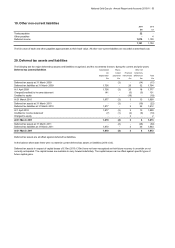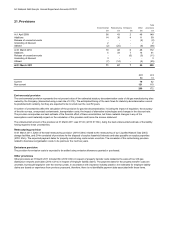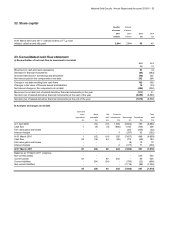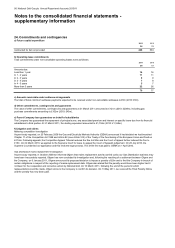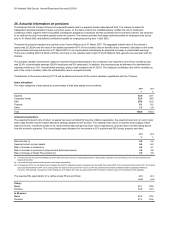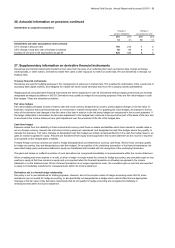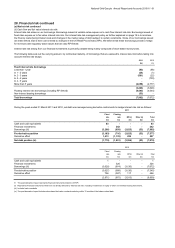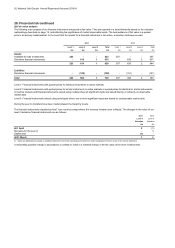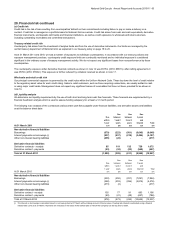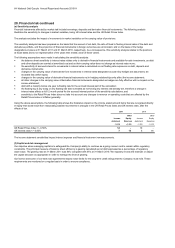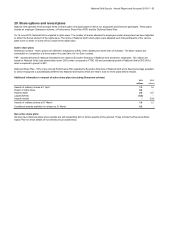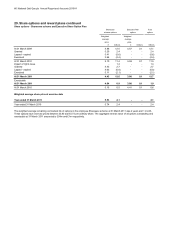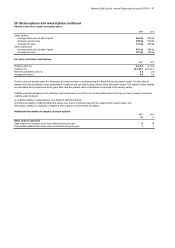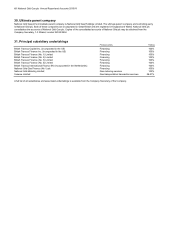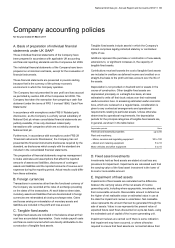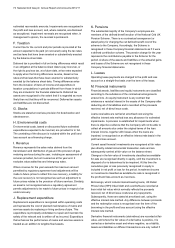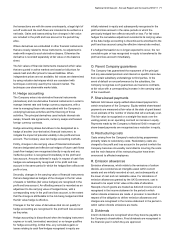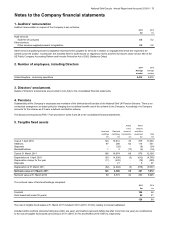National Grid 2011 Annual Report Download - page 65
Download and view the complete annual report
Please find page 65 of the 2011 National Grid annual report below. You can navigate through the pages in the report by either clicking on the pages listed below, or by using the keyword search tool below to find specific information within the annual report.
National Grid Gas plc Annual Report and Accounts 2010/11 63
28. Financial risk continued
(c) Credit risk
Treasury related credit risk
Wholesale and retail credit risk
(d) Liquidity analysis
Due Due Due
Due between between 3 years
within 1 and 2 2 and 3 and
1 year years years beyond Total
At 31 March 2011
£m £m £m £m £m
Non-derivative financial liabilities
Borrowing
s
(679) (223) (501) (6,645) (8,048)
Interest payments on borrowings (i) (237) (237) (219) (3,494) (4,187)
Other non-interest bearing liabilities (455) (22) - - (477)
Derivative financial liabilities
Derivative contracts - receipts 95 119 132 726 1,072
Derivative contract - payments (23) (32) (23) (549) (627)
Total at 31 March 2011 (1,299) (395) (611) (9,962) (12,267)
Due Due Due
Due between between 3 years
within 1 and 2 2 and 3 and
1 year years years beyond Total
A
t 31 March 2010
£m £m £m £m £m
Non-derivative financial liabilities
Borrowing
s
(330) (252) (221) (7,091) (7,894)
Interest payments on borrowings (i) (248) (253) (256) (3,819) (4,576)
Other non-interest bearing liabilities (473) (4) - - (477)
Derivative financial liabilities
Derivative contract - receipts 135 77 91 893 1,196
Derivative contract - payments (60) (41) (48) (637) (786)
Total at 31 March 2010 (976) (473) (434) (10,654) (12,537)
(i)
The counterparty exposure under derivative financial contracts as shown in note 12 was £615m (2010: £637m); after netting agreements it
was £576m (2010: £550m). This exposure is further reduced by collateral received as shown in note 17.
We determine our liquidity requirements by the use of both short and long-term cash flow forecasts. These forecasts are supplemented by a
financial headroom analysis which is used to assess funding adequacy for at least a 12 month period.
The interest on borrowings is calculated based on borrowings held at 31 March without taking account of future issues. Floating rate interest is estimated using a forward
interest rate curve as at 31 March. Payments are included on the basis of the earliest date on which the Company can be required to settle.
Our principal commercial exposure is governed by the credit rules within the Uniform Network Code. These lay down the level of credit relative
to the regulatory asset value for each credit rating. Sales to retail customers, such as those requiring connections, are usually settled in cash
or using major credit cards. Management does not expect any significant losses of receivables that have not been provided for as shown in
note 14.
Counterparty risk arises from the investment of surplus funds and from the use of derivative instruments. Our limits are managed by the
central treasury department of National Grid, as explained in our treasury policy on page 18 to 20.
The following is an analysis of the contractual undiscounted cash flows payable under financial liabilities, and derivative assets and liabilities
as at the balance sheet date:
As at 31 March 2011 and 2010, we had a number of exposures to individual counterparties. In accordance with our treasury policies and
exposure management practices, counterparty credit exposure limits are continually monitored and no individual exposure is considered
significant in the ordinary course of treasury management activity. We do not expect any significant losses from non-performance by these
counterparties.
Credit risk is the risk of loss resulting from counterparties' default on their commitments including failure to pay or make a delivery on a
contract. Credit risk is managed on a portfolio basis for National Grid as a whole. Credit risk arises from cash and cash equivalents, derivative
financial instruments, and deposits with banks and financial institutions, as well as credit exposures to wholesale and retail customers,
including outstanding receivables and committed transactions.


